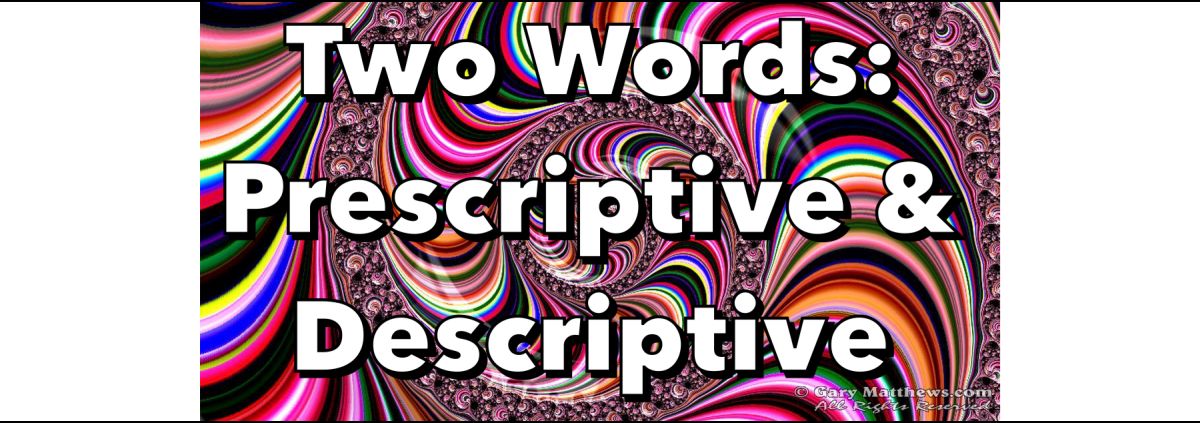In choosing your words, are you prescriptive or descriptive?
There’s nothing necessarily wrong with either one. But you’ll choose words more effectively if you know which approach you’re favoring.
More precisely, you should know where you fall along the spectrum between these two extremes. Because these really are opposite ends of a continuum.
Here’s the scoop: People who compile dictionaries and grammar guides must choose one of two approaches.
The first approach – prescriptive – is to prescribe the “correct” usage according to proper rules.
The second approach – descriptive – is simply to describe what is “standard” according to the way most people actually speak and write. (Or perhaps most “educated” writers and speakers, however one ascertains that.)
Both approaches have serious limitations. If we choose a prescriptive model based on rules – who makes the rules? What are they? How do we determine them?
France has its Académie française (French Academy), a 40-member central authority tasked with propounding official word definitions and grammar rules. Even its rulings, however, are strictly advisory.
Germany, the Netherlands, and some other countries have their own prescriptive authorities. All of them meet robust resistance and criticism.
We have nothing like that for English. Some people mourn that lack. Others celebrate it.
If we go for a purely descriptive approach, accepting things as “correct” merely because “that’s the way people actually talk” – aren’t we embracing anarchy?
Rank-and-file word usage always is in flux, if not outright chaos. Of course it always changes, and always will. But mass media – especially the Internet – have floored the accelerator.
People want rules. We want some authority to tell us whether what we read, say, or hear is correctly worded. We crave that still point in our moving universe.
It’s jangling to hear that we ourselves are the authority. Collectively, anyway. Maybe even individually. How does that work?
Prescriptive rules, however, tend to enshrine the biases of those doing the prescribing. They try (with little success) to freeze language. Typically they favor one region, one social class, one race or ethnic group over another.
There is, however, a different flavor of prescriptivism. It’s commonly known as “political correctness”. It strives to impose rules that discourage sexism, racism, and discrimination in general.
It’s hard to argue with rules that protect us all from language that is hurtful or even hateful. I’m all for banning demographic slurs and damaging stereotypes. (See my recent article on the “singular they”.)
But haven’t we all seen grotesque examples of political correctness carried too far? Doesn’t it sometimes backfire, doing more harm than good to whatever social agenda it’s designed to promote?
Most dictionaries and style guides nowadays adopt an approach that is primarily descriptive. Their findings are then taken – ironically – by many-if-not-most readers as prescriptions!
As noted above, it’s a continuum. It’s a question of emphasis. There’s no such thing as a purely prescriptive or descriptive approach. Each incorporates and depends, to some extent, on the other.
For more background, a good read is Wikipedia’s article on Linguistic Prescription.
(This article is part of my series on words that are #worth1000pictures.)


4 responses to “Two Words: Prescriptive & Descriptive”
I am a firm believer in anarchy, or nonarchy to make a distinction. Anarchy suggests lack of order, complete chaos. Nonarchy (a word I made up) is, to me, orderly and civilized but with no person or persons in charge. Not someone who self-appointed him/herself, not someone others elected, not someone planted there by someone else who was planted there by someone else.. just no one at all. Yet there is order.
The best example of this to me is the Vedas and Hindu philosophy/religion. There is no single, central source that verifies or vets beliefs, principles, etc. Yet, it holds together just fine without disintegrating or auto igniting.
Nonarchy sounds very much like the actual state of language. Especially in English! There is no one in charge, yet the currents of language development aren’t completely chaotic. There’s a kind of crowd-sourced order.
As you note, the same phenomenon can be observed in religion. (At least in some of its forms.) Perhaps especially in science, where certain pragmatic standards are so demonstrably useful that they command general assent.(Replicability, simplicity, predictive power among them.) These generally-accepted standards in turn facilitate organized cooperation, despite the lack of any central authority.
I think “nonarchy” is a wonderful, much-needed word to describe this phenomenon in human interaction. Congratulations on a great coinage!
Coining new words is one of the responsibilities of poets.. hehe..
Interesting explanation ; thanks